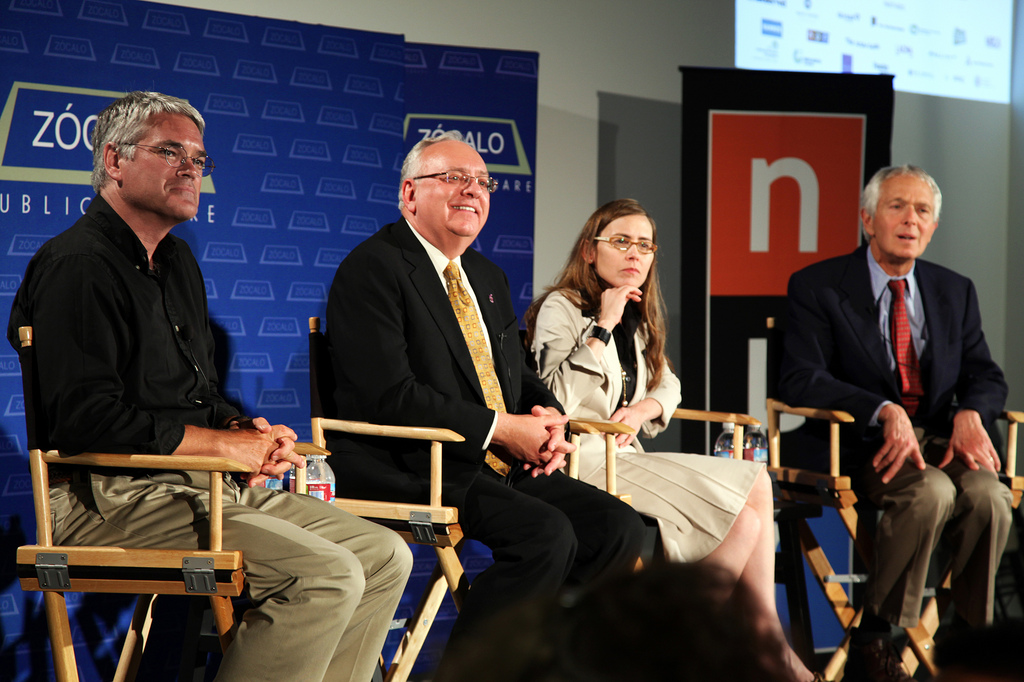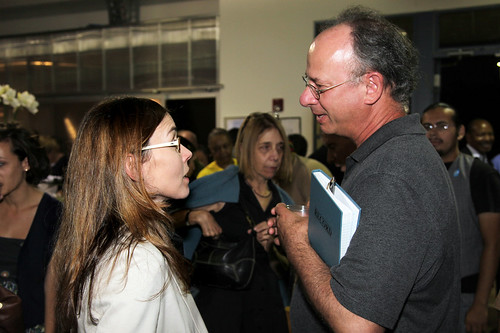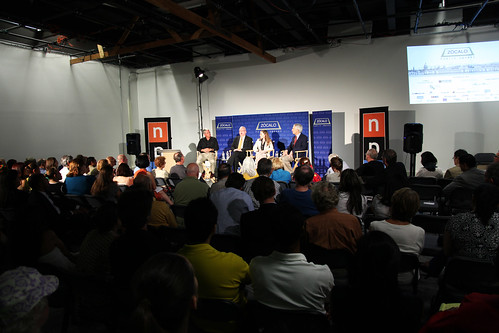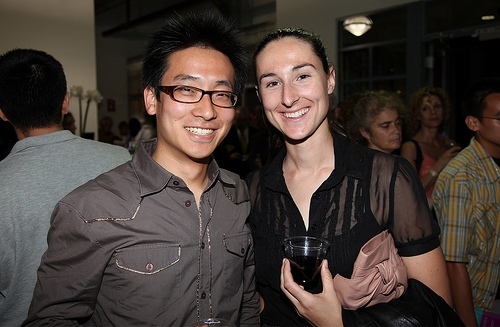
Fifty years ago, the notion of Americans traveling to poorer countries for healthcare would have been considered, according to Arnold Milstein, “a lead-in line to a joke.”
Now, it’s not only plausible, but appealing, and often the only option for patients lacking insurance or money for care. Milstein, U.S. Health Care Thought Leader at Mercer and a quality care expert, explained that medical tourism has grown much more attractive as healthcare costs have for years outpaced income increases. “Some have analogized it to this idea of cooking a frog one or two degrees” at a time, he said wryly to the audience at NPR West.
Milstein joined the panelists – John A Gillean, senior vice president and chief medical officer of CHRISTUS Health, Elizabeth A. Martinez, an anesthesiologist and associate professor at Johns Hopkins University School of Medicine, and Peter Hayes, health benefits strategist at Hannaford Bros. Co – to discuss the rise of medical tourism at an event made possible by a generous grant from the California HealthCare Foundation. As the talk progressed, the panelists considered a broader question: how is medical tourism changing the quality and affordability of healthcare in the U.S.?
Care over there
 As American healthcare has grown more expensive, Milstein noted, large employers and insurance companies have just begun offering Americans the chance to seek care outside the country, saving money for insurers and employers as well as for patients. As the panelists noted, traveling abroad doesn’t necessarily mean a decline in quality of care. Martinez traveled with a team to evaluate six hospitals in Mexico, particularly on orthopedic procedures and cardiac surgery, aiming to compare them to the average community or university hospital in the U.S. Though she emphasized the limits of available data for comparison, and the variation between hospitals, she estimated that about three of the hospitals would be considered at least as good as – and by some measures better than – a U.S. community hospital.
As American healthcare has grown more expensive, Milstein noted, large employers and insurance companies have just begun offering Americans the chance to seek care outside the country, saving money for insurers and employers as well as for patients. As the panelists noted, traveling abroad doesn’t necessarily mean a decline in quality of care. Martinez traveled with a team to evaluate six hospitals in Mexico, particularly on orthopedic procedures and cardiac surgery, aiming to compare them to the average community or university hospital in the U.S. Though she emphasized the limits of available data for comparison, and the variation between hospitals, she estimated that about three of the hospitals would be considered at least as good as – and by some measures better than – a U.S. community hospital.
Gillean, whose organization partners with a hospital in Mexico, noted that the country offers particular advantages when compared to U.S. facilities, especially for some patients. “I went with a certain arrogance to Mexico, thinking I was going to find facilities very inferior to U.S. ones,” he said. “I was very surprised.” Hospitals in Mexico, he said, often “leapfrog” over some of the evolutionary steps of U.S. institutions, meaning they’re more progressive in the data they are able to collect and report. Some medical equipment is available sooner than in the U.S. because Mexico’s approval procedure takes less time than the Food and Drug Administration’s. Care in Mexico is also a good option, he noted, for those near the border who can’t afford care in the U.S.
 Hayes had researched care in Singapore and South Korea, finding both particularly impressive. Singapore, he noted, keeps impressive data on infections, complications, re-admissions, and other indicators of healthcare effectiveness. Korea, meanwhile, actively markets itself as a destination for healthcare, and also excels in data collection and electronic record keeping.
Hayes had researched care in Singapore and South Korea, finding both particularly impressive. Singapore, he noted, keeps impressive data on infections, complications, re-admissions, and other indicators of healthcare effectiveness. Korea, meanwhile, actively markets itself as a destination for healthcare, and also excels in data collection and electronic record keeping.
Cheaper care at home
After visiting Singapore, Hayes took action at Hannaford, promising employees they wouldn’t pay any out-of-pocket costs if they had their hip replacement surgeries in Singapore. Hip replacements in Singapore cost $10,000 on average, Hayes found; they cost $50,000 on average in Maine (one of the more expensive states for care). Soon after, a hospital in Wichita said to him, as he told the crowd: “We’ll do all your hips, knees and hearts for $10,000.” He added, “We laugh, but it really was the first time that it created a marketplace.”
Making care in the U.S. less expensive would help the economy as a whole, too, Hayes  noted. As a healthcare strategist for a grocery store chain owned by a European company, Hayes explained that global companies opt out of the U.S. market because of high healthcare costs. His parent company, he noted, recently opted to build 50 stores in Europe instead of the U.S., meaning Americans lost the opportunity for 10,000 new jobs and $300 million in payroll. “Fifteen million dollars [to build a supermarket] on the ground in Europe over 10 years,” he said, “is worth $8 million more per store than in America because of healthcare.” It’s no coincidence, he argued, that the fastest-growing economic regions in the country, like the Southwest, have low healthcare costs.
noted. As a healthcare strategist for a grocery store chain owned by a European company, Hayes explained that global companies opt out of the U.S. market because of high healthcare costs. His parent company, he noted, recently opted to build 50 stores in Europe instead of the U.S., meaning Americans lost the opportunity for 10,000 new jobs and $300 million in payroll. “Fifteen million dollars [to build a supermarket] on the ground in Europe over 10 years,” he said, “is worth $8 million more per store than in America because of healthcare.” It’s no coincidence, he argued, that the fastest-growing economic regions in the country, like the Southwest, have low healthcare costs.
Better care at home
Much of the battle of lowering healthcare costs, Hayes explained, is improving our preventive care, and reducing unnecessary procedures. “Aging baby boomers aren’t going gracefully. My whole family skis,” he joked. “We’re doing a lot of knee replacements, hip replacements, that kind of thing.” Using more streamlined procedures also allow patients to return to normal life faster, and with a reduced risk of infection, Hayes said.
 But as the panelists also explored, improving quality is a trickier issue, particularly engaging nurses and doctors to do so. Martinez noted that doctors feel overworked, and that any streamlining of record-keeping and data collection would help. Gillean said that doctors generally aren’t employed by their hospital, making it hard for a hospital to mandate any performance or data rules. Encouraging competition among doctors – by comparing them to their peers – and streamlining access to medical data would motivate them to improve quality of care, Gillean suggested. (Though he later noted, as did Milstein in Q&A, that rating physicians is still rudimentary and rare in most states.) Still, he said, most Americans do not use ratings to select their doctors or hospitals, even though as Hayes said, mortality rates can vary by double digits between nearby hospitals.
But as the panelists also explored, improving quality is a trickier issue, particularly engaging nurses and doctors to do so. Martinez noted that doctors feel overworked, and that any streamlining of record-keeping and data collection would help. Gillean said that doctors generally aren’t employed by their hospital, making it hard for a hospital to mandate any performance or data rules. Encouraging competition among doctors – by comparing them to their peers – and streamlining access to medical data would motivate them to improve quality of care, Gillean suggested. (Though he later noted, as did Milstein in Q&A, that rating physicians is still rudimentary and rare in most states.) Still, he said, most Americans do not use ratings to select their doctors or hospitals, even though as Hayes said, mortality rates can vary by double digits between nearby hospitals.
Hayes suggested improving care by making not only ratings but also costs more transparent and regularized, though Martinez noted the difficulty of standardized pricing because of particular patient needs.
Universal care cure-all?
 One thing that wouldn’t necessarily improve care, two panelists seemed to agree during Q&A, is the supposed panacea of single-payer healthcare. Gillean noted that the government is already the largest payer to hospitals, under Medicare and Medicaid, sometimes contributing up to 70% to covering a hospital’s costs. Hayes agreed. “The single-payer discussion is a discussion of how we pay for the healthcare system we have,” he said. “We really need to fundamentally change how we deliver healthcare.”
One thing that wouldn’t necessarily improve care, two panelists seemed to agree during Q&A, is the supposed panacea of single-payer healthcare. Gillean noted that the government is already the largest payer to hospitals, under Medicare and Medicaid, sometimes contributing up to 70% to covering a hospital’s costs. Hayes agreed. “The single-payer discussion is a discussion of how we pay for the healthcare system we have,” he said. “We really need to fundamentally change how we deliver healthcare.”
Meanwhile, in the absence of that change, Martinez and Milstein offered some practical tips for patients. Martinez emphasized finding the best care locally – to keep family and familiar caregivers near – to make sure that an attending physician is closely supervising any resident performing surgery, and to ask which attending physician is available as a back-up. And Milstein said Californians can check out hospital and physician statistics at the state Office of the Patient Advocate.
Watch the video here.
See more photos here.
*Photos by Aaron Salcido.




Send A Letter To the Editors